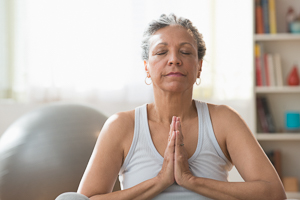stress management: breathing exercises
overview

the way you breathe affects your whole body. full, deep breathing is a good way to reduce tension, feel relaxed, and reduce stress.
roll breathing (also called abdominal breathing)
the object of roll breathing is to develop full use of your lungs and get in touch with the rhythm of your breathing. it can be practiced in any position, but it is best to learn it lying on your back, with your knees bent.
- place your left hand on your abdomen and your right hand on your chest. notice how your hands move as you breathe in and out.
- practice filling your lower lungs by breathing so that your left hand goes up when you inhale and your right hand remains still. always inhale through your nose and exhale through your mouth. keep your shoulders relaxed, and don't shrug them.
- when you have filled and emptied your lower lungs 8 to 10 times, add the second step to your breathing: inhale first into your lower lungs as before, and then continue inhaling into your upper chest. as you do so, your right hand will rise and your left hand will fall a little as your abdomen falls.
- as you exhale slowly through your mouth, make a quiet, whooshing sound as first your left hand and then your right hand falls. as you exhale, feel the tension leaving your body as you become more and more relaxed.
- practice breathing in and out in this manner for 3 to 5 minutes. notice that the movement of your abdomen and chest is like rolling waves rising and falling in a rhythmic motion.
practice roll breathing daily for several weeks until you can do it almost anywhere, providing you with an instant relaxation tool any time you need one.
caution: some people get dizzy the first few times they try roll breathing. if you begin to hyperventilate or become light-headed, slow your breathing. get up slowly.
morning breathing
try morning breathing when you first get up in the morning to relieve muscle stiffness and clear clogged breathing passages. then use it throughout the day to relieve back tension.
- from a standing position, bend forward from the waist with your knees slightly bent, letting your arms dangle close to the floor.
- as you inhale slowly and deeply, return to a standing position by rolling up slowing, lifting your head last.
- hold your breath for just a few seconds in this standing position.
- exhale slowly as you return to the original position.
clearing your head
clearing your head is good for relieving neck tension or for when you have too much on your mind.
- begin with several very slow neck rolls. with your chin on your chest, or close to it, roll your head up and to the right, slowly inhaling until your head is leaning back and your chin is pointing toward the sky. if you have arthritis of the neck (cervical spine) or other diseases of the spine, do not point your chin to the sky.
- hold your breath for just a few seconds in this position.
- as you roll your head down the way you went up, slowly exhale until your chin is back on your chest.
- repeat, this time rolling your head to the left.
credits
current as of: june 24, 2023
author: healthwise staff
clinical review board
all healthwise education is reviewed by a team that includes physicians, nurses, advanced practitioners, registered dieticians, and other healthcare professionals.
current as of: june 24, 2023
author: healthwise staff
clinical review board
all healthwise education is reviewed by a team that includes physicians, nurses, advanced practitioners, registered dieticians, and other healthcare professionals.